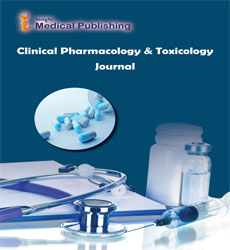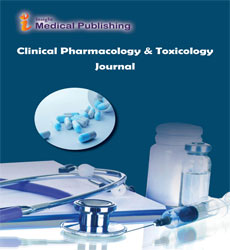Selenium in Brazil-Nut Milk: Is It Safe?
Ariane M Kluczkovski*, Natacha Lima and Maria Oliveira
Faculty of Pharmaceutical Sciences, Department of Pharmaceutical Sciences, Federal University of Amazonas, Av. General Rodrigo Octávio Jordão Ramos, Manaus, Amazonas, Brazil
- *Corresponding Author:
- Ariane M Kluczkovski
Faculty of Pharmaceutical Sciences, Department of Pharmaceutical Sciences
Federal University of Amazonas, Av. General Rodrigo Octávio Jordão Ramos, Brazil
Tel: +55 92 3305-1480
E-mail: mendonca-ariane@hotmail.com
Received Date: 26 September 2017; Accepted Date: 26 September 2017; Published Date: 15 October 2017
Citation: Kluczkovski AM, Lima N, Oliveira M (2017) Selenium in Brazil-Nut “Milk”: Is It Safe? Res Rep Toxi. Vol.1 No.1:2
Abstract
Studies on Brazil nut (Bertholletia excelsa H.B.K.) and their products revealed its antioxidant benefits, especially due to the Selenium (Se) level, naturally present in Brazil nuts. In order to study toxicological risks to consumers, the aim of this work was to evaluate the Brazil nut powdered “milk” (by atomization). The powdered “milk” showed Se content of 1.200 μg/100 g after atomization. Thus, when one considers the consumption of a tablespoon (10 g) of the powdered product diluted in a 200 ml glass, 60 μg/Se is proportionally obtained and this value is under the Se Recommended Daily Intake (RDI) for humans. In conclusion, the Se levels found in Brazil nuts “milk” were safe to consumers and higher than soybean milk, vegetable “milk”.
Keywords
Bertholletia excelsa; Atomization; Antioxidant
Introduction
The Brazil nut (Bertholletia excelsa H.B.K.) is well-known worldwide due to the Selenium (Se) content and their antioxidant and clinical benefits [1]. Se has been reported as an important micronutrient and Brazil nuts are a source, there has been an increasing interest by consumers in that commodity. Brazil nuts have been recommended to be consumed, either as is or as an ingredient in processed food [2].
Because Se has been considered as an excellent antioxidant, it has been recommended as anti-aging and is consumed by athletes, the elderly, and those that desire a healthy life. Thomson et al. [3] suggested that consuming two nuts/day (approximately 60 μg/Se) would be enough to trigger the antioxidant effect. The tolerable upper nutrient uptake level (UL) for adult individuals is 400 μg/day [4,5].
It is important to emphasize some metals can be absorbed from soil according to different geographic region. It happens to the Brazil nut tree as an accumulating plant. In this context, some Brazil nuts can exceed the safe level of some chemicals and become toxic [6]. The health-related properties attributed to some functional foods may derive from their natural constituents or from the addition of ingredients that change the food original properties.
Therefore, industries have been seeking different production methods to meet the consumers’ demands for healthier and natural products. Using the spray drying method has allowed developing new foods [7]. In order to study toxicological risks to consumers, the aim of this work was to produce the Brazil nut powdered “milk” and evaluate the Selenium level.
Material and Methods
The Brazil nut powdered milk was obtained according Kluczkovski et al. [8]. Different lots of Brazil nuts are coming from processing plants in the Brazilian Northern region. The nuts were visually selected, and those looking injured or showing stains were removed from the lot.
Atomization
Each lot was analyzed for acid index, moisture content (mc), and for total aflatoxin content, according to the Association of Official Analytical Chemists [9], in order to evaluate raw material quality. The Brazil nuts were dehulled by soaking in 2% sodium hydroxide (NaOH) at the ratio 2:1 (NaOH: Brazil nut). They were boiled for 1 min, dried at 70°C in an oven and placed in cold water for 10 min, and then manually dehulled under running water and immersed in cold water for 10 min to remove NaOH residues. NaOH absence was checked using 0.1% phenolphthalein solution drops. After dehulling, the nuts were pressed (mechanical pressing in Tecnal®), to separate the oil and the Brazil nut “cake”.
The residue (cake) was packed in aluminum foil and in plastic bags (300 g each) and it was stored under refrigeration (-18°C). As for extract obtainment, the “cake” was homogenized in a blender with filtered water at 75°C, at the ratio 2:1 (water: cake) for 3 min. until it got homogeneous consistency. It was then filtered and centrifuged to obtain the water-soluble extract.
The extracts were added up with: 500 ppm citric acid and 0.2% w/v potassium sorbate. They were packed in 100 mL Nylon-polyethylene thermally sealed bags, pasteurized at 72 ± 2°C for 20 min, and cooled by immersion in ice. They were stored under refrigeration after reaching room temperature (20°C). The dry extract was obtained using a Mini Spray Dryer (Model MSD 1.0) by Labmaq Brasil with 1.0 mm vacuum diameter. The drying operating conditions were (a) Temperature: 140°C inlet and 90 ± 3°C outlet; and (b) 6.5 mL/min feeding flow.
Selenium analysis
The selenium analysis was performed with optical emission spectrometry, using the atomic emission method [10]. The digestion of the samples (0.4 g) was carried out using 5 mL of concentrated HNO3. The limit of detection (LOD) was 2.00 mg/kg, and the limit of quantification (LOQ) was 3.50 mg/kg. LOQ was defined as the lowest point of the calibration curve with high repeatability, axial view. The recovery was 92%.
Results and Discussion
The Brazil nut powdered milk showed Se content of 1.200 μg/100 g at the end of the processing. Thus, when one considers the consumption of a tablespoon (10 g) of the product diluted in a 100 ml glass, 120 μg/Se is proportionally obtained. Based on the glutathione (GSH- Px) enzyme’s activity maximization, this value is above the Se recommended dietary allowance (RDA) (55 μg/day) for an adult human. Thus, the dry product use must be oriented with emphasis in the product dilution and in the previous Se content analysis, in each produced lot, in order to avoid the toxicity level to the consumer, since the Se content in the raw material varies.
Se is present in sulfur amino acids such as selenomethionine and selenocysteine in plants. These plants show different capacities to absorb and accumulate the Se from the soil and are classified as accumulating or non-accumulating plants. The Brazil nut tree is an example of Se accumulating plant, but it may vary according to the geographic area in the Amazon region.
On the other hand, in the case of non-accumulating plants, such as soybeans, this element’s concentration limit is at most 6 μg/100 g, even when the plants are grow in seleniferous soils [11,12] evaluated raw material for beverage production and Brazil nuts presented higher content of Se (3.44 mg/100 g) than compared to dehulled soybeans (0.88 mg/100 g). According to Turakainem et al. [13], Se has the property to improve plant capacity and to combat the oxidative stress caused by oxygen free radicals. On the other hand, the presence of high concentrations of it in the plant may cause toxicity and enable oxidative reactions.
A study conducted by Souza and Meneses [14] found amounts of 713 μg/100 g in Brazil nut “cake” (material after oil extraction). It helps justifying that the Se content found in Brazil nut products may reach levels above those recommended for beneficial effects on human health. Thus, the industry must evaluate each produced lot, since the Se content in the raw material varies according to the geographic region. It is import to emphasize the correct dilution in the labeling information of the product, in order to avoid the Se toxic level to the consumers.
Conclusion
The Brazil nut milk powder showed the Se contents higher than the values obtained in the dried nuts (raw material). Thus, these contents require special attention in the raw material analytical evaluation in the product preparation, since the spraying process seems to increase the content of these variables. Thus, the Brazil nut milk powder seems to be safe and may be used in the food industry as raw material and alternative ingredient regarding food developed for special purposes. It is also necessary to define the probable consumer public, such as vegetarians or people who need protein supplement as an alternative to cattle dairy products, such as individuals with lactose intolerance.
Acknowledgment
FAPEAM-Foundation Support of Research of the State of Amazonas.
References
- Hughenigen GVB, Oliveira GMM, Moreira ASB, Saint Pierre TD, Gonçalves RA, et al. (2015) Improvement of antioxidant status after Brazil nut intake in hypertensive and dyslipidemic subjects. Nutr. J 14:1-10.
- Kluczkovski AM, Martins M, Mundim SM, Simões RH, Nascimento KS (2015) Properties of Brazil nuts: A review. Afr J Biotechnol 14:642-648.
- Thomson CD, Chisholm A, Mclachlan SK, Campbell JM (2006) Brazil nuts: An effective way to improve selenium status. Am J ClinNutr 87:379–384.
- Institute of Medicine (2000) Selenium:Dietary reference intakes for vitamin C, vitamin E, selenium and carotenoids. National Academy Press,Washington DC, USA, pp 284- 324.
- World Health Organization, Food and Agricultural Organization of the United Nations (2004) Vitamin and mineral requirements in human nutrition.(2nd edn),WHO Library, Bangkok, Thailand.
- Pacheco AM, Scussel VM (2007) Selenium and aflatoxin levels in raw Brazil nuts from Amazon basis. J. Agr. Food Chem 55:11087-11092.
- Gharsalloui A, Roudat G, Chambin O, Voilley A, Saurel R (2007) Applications of spray-drying in microencapsulation of food ingredients: An overview. Food Res Int 40:1107-1121.
- Kluczkovski A, Lima N, Oliveira M (2016) Brazil nut powdered milk properties. J Food Process. Preserv 1-6.
- Association of Official Analytical Chemists (AOAC) (2005) Official Methods of Analysis of the AOAC International, (16thedn). Gaithersburg, USA.
- United States Environmental Protection Agency (1996) inductively coupled plasma-atomic emission spectrometry. SW846 test methods for evaluating solid wastes physical/chemical methods, method 6010B. U.S. Environmental Protection Agency.
- Whanger PD (2002) Seleno compounds in plants and animals and their biological significance. J Am CollNutr 21:223-232.
- Felberg I, Antoniassi R, Deliza R, Freitas SC, Modesta RCD (2009) Soy and Brazil nut beverage: Processing, composition, sensory, and color evaluation. Ciênc. Tecnol. Alimentos 29: 609-617.
- TurakainemM, Hartikainen H, Sepanen M (2005) Selenium in plants. In: Eurolam,Hietamniemi V(eds) In: Twenty years of selenium fertilization, Finland.
- Souza ML, Menzes HC (2004) Processing of almond and almond pie of Brazil nut and cassava flour: Quality parameters. CiêncTecnol. Aliment 24: 120-128.

Open Access Journals
- Aquaculture & Veterinary Science
- Chemistry & Chemical Sciences
- Clinical Sciences
- Engineering
- General Science
- Genetics & Molecular Biology
- Health Care & Nursing
- Immunology & Microbiology
- Materials Science
- Mathematics & Physics
- Medical Sciences
- Neurology & Psychiatry
- Oncology & Cancer Science
- Pharmaceutical Sciences
